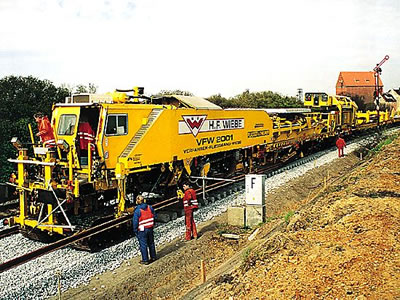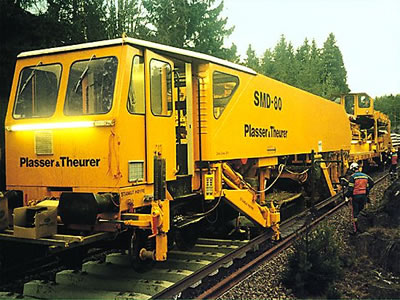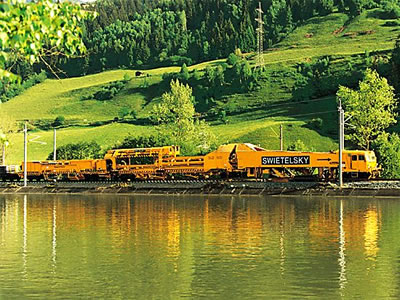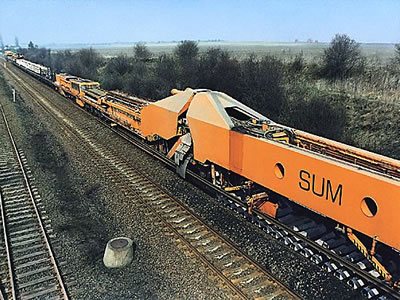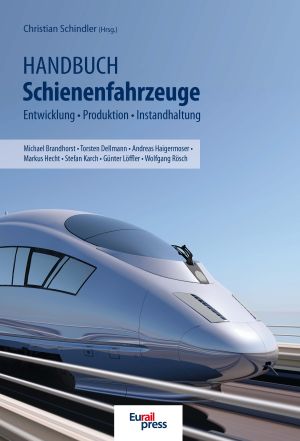Machines for track renewal
UVP 2002:
- Machine for renewal, laying and removal of track.
- Rail fastening collector with magnetic drum and transport system, as well as a conveyor belt that can be mechanically displaced lengthwise.
- Old sleeper removal unit and conveyor system.
- Ballast regulating device with spiral conveyor and laser height control to produce a perfect bearing surface for the new sleepers.
- Laying of new sleepers using a vacuum grab for especially careful treatment of the new sleepers.
- The rail threading and laying machine SEW is used to position the new rails.
- Crawler tractor with high tractive force.
- The long construction gap ensures a gentle bending line and, thus, careful handling of the rails.
- Gantry crane unit to transport 20 concrete sleepers and an automatic timber beam grabbing unit.
- When laying new track, the crawler track is mounted in place of the rear bogie. During this process, the direction of travel is reversed and the material train is pulled by the machine.
SMD 80:
- Unit and conveyor system to remove and take away old sleepers.
- Even large quantities of ballast present no problem for the production of a proper sleeper bed when using a ballast regulating chain with cross-conveyor belts.
- SMD80 has a crawler tractor for high tractive power, even in wet weather and on gradients.
- Accurate new sleeper laying - gantry crane to take away the old sleepers and supply new sleepers.
- With the help of the most modern controls either the existing track geometry can be retained or the new track can be laid displaced onto a different longitudinal level and alignment.
- The power unit is mounted on a wagon which is supplied by the customer.
SUZ 500:
- Design with towed sleeper train for track renewal and track laying.
- Crawler tractor for highest tractive effort.
- The two frame sections of the main machine are raised by turning a spindle before work is started to raise the middle bogie; this creates a sufficiently long construction gap .
- After removal of old sleepers, the ballast subgrade is prepared by an excavating and grading chain.
- Shoulder ploughs for fixing the newly laid track at the sides.
- Gantry crane for transporting old and new sleepers.
- The new track can be laid either to follow the old one or displaced from the old longitudinal level and alignment.
SUM-Q:
- The material train of this high-speed relaying machine is pushed during the working Operation.
- The two frame sections of the main machine are raised by turning a spindle before work is started to raise the middle bogie; this creates a sufficiently long construction gap.
- An additional device to push out the old sleepers and enable broken sleepers to be removed.
- The ballast formation is prepared by an excavating chain with a transverse conveyor belt; large quantities of ballast present no problem.
- Gantry crane to supply new sleepers and take away old sleepers.
- Sleepers are loaded crosswise to the track axis.
- The pre-dumped new rails are carefully threaded in, avoiding excessive stresses.
- The rear section of the machine already runs on the newly laid track.
- Integrated material wagon with sleeper end ploughs.
You can find suitable specialist literature to the topic here:
Handbook Railway vehicles (German)
This book fills the gap in the market between the numerous theoretical works, which are limited to one topic or few specific topics on rail vehicle technology, and the books for professionals. The target group for this book is students of railways and rail vehicle technology as well as professionals from the industry who wish to refresh or supplement their Knowledge.
In nearly 190 years of railway history, rail vehicle technology has constantly developed. Today the technical knowledge necessary for the development, construction, operation and maintenance is so complex and extensive that it can not be comprehensively mastered by a single specialist alone.
The Basic Principles of Mechanised Track Maintenance
This book is dedicated to the many people involved in the day to day planning and performance of track maintenance activities. Providing a practical approach to everyday challenges in mechanised track maintenance, it is not just intended as a theoretical approach to the track system.
Railways aim at transporting people and freight safely, rapidly, regularly, comfortably and on time from one place to another. This book is directed to track infrastructure departments contributing to the above objective by ensuring the track infrastructure’s reliability, availability, maintainability and safety – denoted by the acronym RAMS. Regular, effective and affordable track maintenance enable RAMS to be achieved.

